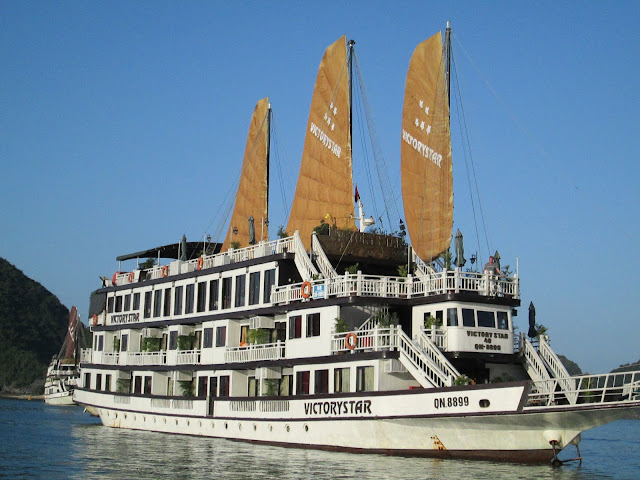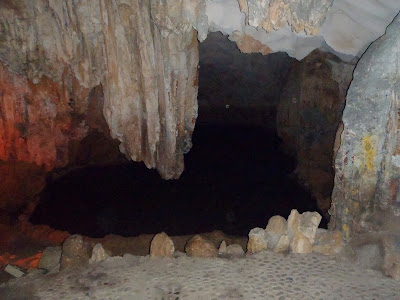Halong Bay
On February 5, we left Hanoi with the Klines on a four hour drive to Halong Bay. Halong Bay’s is located on the northeast coast of Vietnam on the Gulf of Tonkin. Actual counts vary, but most sources agree that there are over 2000 limestone towers and islets which make up this Karst Landscape. It was designated a UNESCO World Heritage Site in 1994 and in 2009, one of the New 7 Wonders of Nature. Our private car took us to the pier in Halong City, which has little to commend itself other than a place to stay and eat. From the dock, we transferred by tender to our junk, The Victory Star.
 |
| Our junk. The sails are for show only, but look impressive. |
 |
| Tourist junk before 2012 |
The Junks: Before 2012, the wooden junks were mostly dark brown. The Quang Ninh’s People’s Committee, issued a decision in 2011 that all tourist boats, except dragon boats, would be painted white with brown sails. Boats which failed to conform would have their licenses revoked.
The move was aimed to tighten government control over tourist transport, especially the boats providing over-night accommodations in Ha Long Bay. The decision also aimed to enhance and create a unique image for boats sailing in Halong Bay, after the Bay was named a ‘New7Wonders of Nature’. Soon after the decision came down, which affected more than 500 boats, cruise operators reacted, saying the change was unnecessary, because tourists prefer the traditional brown of Ha Long Bay’s wooden boats, adding that costs and time to repaint were prohibitive. As a result to this fierce opposition from Halong bay cruise operators, the Quang Ninh’s people’s committee decided to soften its decision and impose the use of white color for some details only. As it turned out, almost all the junk had to be painted white, leaving only a small amount of trim left in the original dark colour.
 |
| View from our stateroom. |
Our stateroom was comfortable with a small balcony and large bathroom, with both a tub and a shower.
Formation: Halong Bay is a mature Karst environment: more limestone has been eroded away than remains. Karst topography is characterized by subterranean limestone caverns and extensive cave systems, which are dissolved from the limestone over millions of years. These karst outcrops are made of sediment that settled on the ocean floor millions of years ago and which ultimately rose to the surface through upheaval and erosion. The limestone dissolved easily in the mild carbonic acid commonly found in rain water. As water seeped into natural faults and cracks in the limestone, it slowly dissolved the rock and gradually widens the cracks and faults into tunnels and caves. Halong Bay is one of the best examples of tower Karst in the world.
 |
| Cruising the Bay towards Hang Sun Sot |
 |
| Paul and Randy in Sung Sot Cave |
Hang Sun Sot (Cave of Surprises) is the largest cave in Halong Bay. From the pier, there are 156 stone steps which lead up into a series of 3 large chambers. There is a stone and pavement path over 500 metres long that directs tourists from entry to exit. Certain features are illuminated in an interesting way, without spoiling the 'cave' experience. On exiting the cave, there were fantastic views across the Bay.
 |
| Hang Sung Sot |
 |
| part of the welcoming committee |
On exiting the cave, there are a number of wooden and stone steps leading back to the pier. This fellow was sitting calmly on the railing as we walked by. Our guide called him a yellow monkey, but I have been unable to find any information about this species.
The Legend: Many years ago, soon after the Viet people settled in the area, invaders came. The Emporer called to the heavens to Mother Dragon and her children to come to earth and help the people vanquish the enemy. As they charged towards the coast, their flailing tails gouged out valleys, crevasses, peninsulas and beaches. They arrived at the shore at the same time as the invaders and they immediately spat pearls from their mouths, which turned into thousands of stone islands. The enemy boats could not stop in time and crashed into the islands. The boats were destroyed and no one survived. Halong Bay (descending dragon) was named in honour of the Dragons and their victory.
 |
cruising the Bay
|
 |
| entrance to Luon 'Cave' |
 |
| inside 'Luon Cave' |
We visited Luon Cave by rowboat. Not really a cave: called a lagoon by our guide, but presumably salt water. The lagoon is called Rua Lake.
The limestone walls surrounding the lake rise almost straight up, 10 to 15 metres. Still, many monkey families manage to survive in this area. There were areas of luxurious tree and plant growth and many hanging orchids.
 |
| a tiny formation in the middle of the Bay |
It is interesting how the cruises work. Most boats offer a 1 night/two or 2 night/three day cruise. Both are mixed on the same boat. In order to co-ordinate two different schedules, on the second day, the 3 day guests are taken onto a 'private day boat' while the 'mother ship' takes the remaining guests to some sites and returns them to the pier. Our day boat was large and comfortable, and an amazing seafood lunch was served.
|
|
| Relaxing on the day boat! |
 |
Also relaxing on the day boat as we cruise to the
floating fishing village. |
The day boat took us to Cua Van village. There are several in Halong Bay and they include not only hoseboats, but also floating fuel stations, herb gardens, kennels and even pigpens!
 |
| Our rower for our tour of the fishing village |
A community of around 1,600 people live on Halong Bay in four fishing villages. They are sustained through fishing and cultivating other marine plant and animal life. Over 200 species of fish and 450 different kinds of mollusks live in the shallower waters of the bay.
 |
| Washing up in the fishing village |
 |
| house boats in Cua Van village |
 |
| Kayaking through Halong Bay |
 |
| Climbing to the top of Soi Sim Island |
 |
| View from the top - beach visible in centre |
Halong Bay was really a wonder, with its striking karst landscape and traditional way of life. Sadly, it appears that tourism is having a disastrous impact on the area. In October 2011, the World Monuments Fund included the bay on the 2012 World Monuments Watch, citing tourism pressures and associated development as threats to the site that must be addressed. The goal of Watch-listing is to promote strategies of responsible heritage-driven development for a sustainable future.
Unfortunately, we observed first-hand the impact of tourism on this breathtaking natural area. As we cruised, we could see the plastic bags and bottles and lots of other garbage floating by. Kayaking was great, but we had to paddle through a stream of debris before we reached our secluded destination. We swam only once, on our first evening at Titov island (named in honour of Russian cosmonaut, Gherman Titov, in 1962). There was an artificial beach and beautiful sunset and we went for a chilly dip in, what looked like, pristine waters. That was the last swim we had!
Still, in spite of the pollution, Halong Bay is a natural wonder. And the cruise junk was an excellent way to see it - the food, activities and accommodations were excellent.




















No comments:
Post a Comment